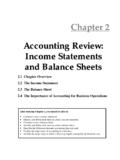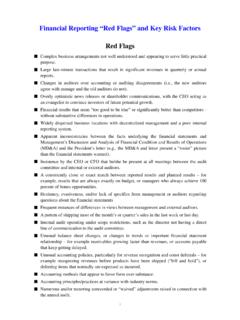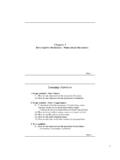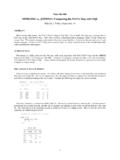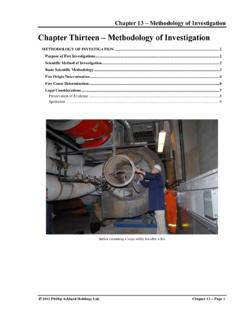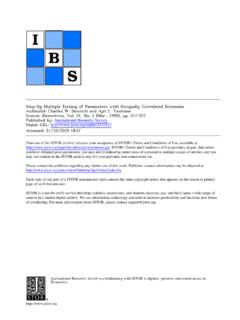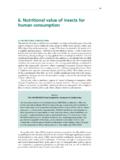Transcription of Factorial Analysis of Variance Statistically Significant ...
1 1 Factorial Analysis of VarianceStatistically Significant Interactions: What s the next step ? Oshima and F. McCartyGeorgia State UniversityThe purpose of this handout is to assist the burgeoning statistician in analyzing (using SPSS) andinterpreting the meaning of a Statistically Significant interaction in the context of Factorial Analysis ofvariance (ANOVA). We shall assume that the reader is already familiar with the results obtained whenfactorial ANOVA is the chosen analytic technique. However, just to be on the safe side, we will review thebasics as we go through two examples demonstrating two of the methods that can be used as a follow-upto a Statistically Significant interaction effect. The two approaches that we will discuss are: 1. tests ofsimple main effects, and 2. statistical comparison of cell means. Remember, an interaction effect exists when the effect of one independent variable on the dependentvariable depends on the value (level) of some other independent variable included in the study design.
2 Inother words, the test of an interaction focuses on the question of whether or not the effect of one factor isthe same for each level of the other factor. In either case, our interest shifts to the cell means, not themarginal means (row and column means). Remember, tests of the main effects focus on the a Statistically Significant interaction is found we avoid interpreting the main effects and interpret theinteraction effect. Interpreting the main effects in the presence of a Statistically Significant interaction couldlead us to erroneous approach to considering interaction effects calls on the researcher to specify a focal and a moderatorindependent variable. The focal independent variable ( , teaching method, counseling method) can bethought of as the variable whose effect on the dependent variable is thought to be moderated by someother independent variable included in the study ( , aptitude, gender). It may be useful to think of thefocal independent variable as the variable of primary interest to the researcher.
3 On the other hand, themoderator variable may be thought of as a variable of interest because of its potential impact on the effectsof the independent variable that is the primary focus of the study. Another useful distinction that can beapplied to the independent variables in a study is the assigned-active distinction. It will often be the casethat an assigned (characteristic intrinsic to the participant) independent variable will be designated as themoderator variable and the active (characteristic determined by the researcher) independent variable willbe considered the focal variable. In many cases, this designation can be made on conceptual groundsand can be quite useful when considering interaction effects. However, one should not worry if thisdesignation cannot be easily made, because the results of the interaction Analysis will be unaffected by thedesignation. We shall see in our second example, where both independent variables would be consideredactive independent variables (course length & homework status), that the focal-moderator distinction maynot be needed to facilitate interpretation of the interaction.
4 In this case, the groups formed by thecombinations of the two independent variables can be meaningfully compared, therefore, the statisticalcomparison of cell means could be applied. However, many study designs will have a combination ofactive and assigned (focal and moderator) independent variables which leads us to the first approach tothe follow-up of a Significant interaction effect, tests of simple main of Between-Subjects EffectsDependent Variable: SCORE stress inventory ModelInterceptMETHODGENDERMETHOD * GENDERE rrorTotalCorrected TotalType IIISum Squared = .572 (Adjusted R Squared = .547)a. TESTS OF SIMPLE MAIN EFFECTSC onducting a test of simple main effects involves examining the effect of one of the independent variables(focal, active) at a fixed level of another independent variable (moderator, assigned) included in the study. We can accomplish this by comparing the cell means on individual rows and/ or columns in a design withtwo factors (independent variables).
5 Let s consider an example. EXAMPLE 1:A researcher is interested in examining the effects of three methods of stress reduction (yoga,meditation, and exercise). Based on previous research, the researcher feels that gender mayhave some impact on the effects of stress reduction efforts. With this in mind, the researcherdesigned a study in which 90 participants (45 males and 45 females) were randomly assigned toone of the three stress reduction methods. At the conclusion of the study period, each participantcompleted a stress inventory (lower scores indicate less stress). The data were then analyzedusing Factorial ANOVA. Dependent variable:amount of stress as measured by a stress inventoryIndependent variables:method of stress reduction - three levels (yoga, meditation, exercise)gender - two levels (male, female)Data set-up:SPSS data file with three variables - stress inventory score (score); method ofstress reduction (method) with yoga coded as 1, meditation coded as 2, andexercise coded as 3; gender (gender) with male coded as 1 and female codedas 2.
6 Note: The data for this example can be found in the s consider the initial Analysis and look at the output obtained when SPSS is used to analyze thedata:If we look at the ANOVA table, we can see that the METHOD x GENDER interaction is Significant (F= , p=.000). In addition, both the method and gender main effects are Significant (F= , p=.000;F= , p=.003). However, recall that when an interaction is Significant , we focus our attention on theinteraction and not the main effects. 3 Descriptive StatisticsDependent Variable: SCORE stress inventory gender1 male2 femaleTotal1 yoga2 meditation3 exerciseTotalMETHOD stress reduction methodMeanstress reduction methodexercisemeditationyogaMean stress inventory score5045403530gendermalefemaleLet s have a look at the means. The means that are in the lightly shaded area are the cell means and areof interest when considering an interaction effect. The marginal means, in the column and row labeled Total , are the means that we are concerned with when looking at main effects.
7 Again, the mean in thelower right corner (gray area) is the grand mean. So, what do we do next? In this example, we will use the simple main effects approach to examine theinteraction effect. First, let s make our focal and moderator distinction. Given the researcher s focus andthe nature of the independent variables, it would seem appropriate to designate method of stress reductionour focal independent variable with gender as the moderator variable. This distinction will help us set upour tests of simple main effects. Recall from our previous discussion that an interaction exists when theeffect of one independent variable is dependent on the level of the other independent variable in thedesign. Using our focal- moderator distinction, our initial Analysis indicates that, for this example, theeffect of method of stress reduction (focal) depends on the level of gender (moderator). While this isinformative, we would generally like to know more.
8 We will use the simple main effects approach to furtherelucidate the meaning of our Significant interaction. However, before we move on to the significance testing aspects of this approach we will first examine agraph of the cell means. This is a useful first step in considering an interaction effect. The following graphof the cell means, which helps us visualize the interaction effect, was obtained by using the Plots optionfound in the General Linear Model(GLM)-Univariate procedure used to run the initial Analysis : 4As suggested previously, you can obtain a graph of the interaction when conducting the initial Analysis (GLM-Univariate). After you have specified your dependent variable and the fixed factors, these additionalsteps will allow you to obtain the interaction graph:--->PlotsHorizontal axis: method Separate lines: gender --->Add --->Continue--->OKUsing SPSS , we will now go through the steps needed to produce the Analysis necessary to conducttests of simple main effects.
9 The focus here will be on using a menu driven interface ( , pointing andclicking) to conduct the Analysis . There are some time saving methods, included in the Appendix, thatmore advanced SPSS users may want to consider. However, as you will see, all analyses can be carriedout successfully without employing the methods included in the : Your original data file (similar to the one described above) should be open when you begin. 1. The first step is to identify the variable that we will hold constant. We have essentially done this bymaking our focal-moderator distinction. In most cases, you will want to perform the simple main effectsanalysis while holding the moderator variable constant. What this means is that we will be conductinga separate Analysis of Variance for each level of the moderator variable. In our example, we willanalyze the effects of method of stress reduction for females and males, easiest way to do this is to use the split-file option.
10 We will split our file using the moderatorvariable. To do this (you need to be in the data file window):Data >Split file, Click the circle beside organize output by groups , the boxlabeled Groups based on will become white, move the moderator variable(gender) over from your list on the left ----> OKGo back to the data file window, you should see split file on in the lower right corner. At this point,any Analysis that you choose to run will be run on each level of the above chosen variable. For ourexample, all subsequent analyses will be run on females and males, Now, we are ready to run the Analysis that we need to follow-up our Significant interaction effect. Wewant to look at the effect of the focal independent variable at each level of the moderator variable. Todo this, we simply need to run a one-way ANOVA for males and females, separately. There areseveral ways to accomplish this using SPSS, we will use the compare means >Compare Means > One-way ANOVAD ependent List: score Factor: method ---->Options, Click Descriptives box---->Continue---->OKWe now have the analyses that we need , but there are some calculations that we need to stress inventory yoga2 meditation3 ErrorLowerBoundUpperBound95% ConfidenceInterval for MeanMinimumMaximumGENDER gender = 1 male1.

